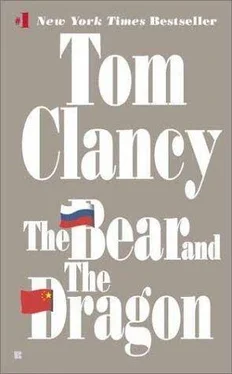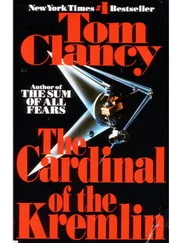Tom Clancy - The Bear and the Dragon
Здесь есть возможность читать онлайн «Tom Clancy - The Bear and the Dragon» весь текст электронной книги совершенно бесплатно (целиком полную версию без сокращений). В некоторых случаях можно слушать аудио, скачать через торрент в формате fb2 и присутствует краткое содержание. Год выпуска: 2001, ISBN: 2001, Жанр: Триллер, на английском языке. Описание произведения, (предисловие) а так же отзывы посетителей доступны на портале библиотеки ЛибКат.
- Название:The Bear and the Dragon
- Автор:
- Жанр:
- Год:2001
- ISBN:780425180969
- Рейтинг книги:3 / 5. Голосов: 1
-
Избранное:Добавить в избранное
- Отзывы:
-
Ваша оценка:
- 60
- 1
- 2
- 3
- 4
- 5
The Bear and the Dragon: краткое содержание, описание и аннотация
Предлагаем к чтению аннотацию, описание, краткое содержание или предисловие (зависит от того, что написал сам автор книги «The Bear and the Dragon»). Если вы не нашли необходимую информацию о книге — напишите в комментариях, мы постараемся отыскать её.
The Bear and the Dragon — читать онлайн бесплатно полную книгу (весь текст) целиком
Ниже представлен текст книги, разбитый по страницам. Система сохранения места последней прочитанной страницы, позволяет с удобством читать онлайн бесплатно книгу «The Bear and the Dragon», без необходимости каждый раз заново искать на чём Вы остановились. Поставьте закладку, и сможете в любой момент перейти на страницу, на которой закончили чтение.
Интервал:
Закладка:
“If we live, I will see you promoted, Colonel.”
“I’ve always wanted to be a general officer. But I want to see my children enter university, too. So, let’s try to stay alive.”
“What of the border troops?”
“I have transport assigned to each post-where possible, two sets of transport. I’ve sent some of the reservists in BTRs to make sure they have a little protection against the artillery fire when they pull out. We have a lot of guns in the photos from the M-5, Comrade General. And fucking mountains of shells. But the border troops have ample protection, and the orders have gone out so that they will not need permission to leave their posts when the situation becomes untenable-at the company-officer level, that is,” Aliyev added. Commissioned officers were less likely to bug out than enlisted men.
“No word on when?”
The G-3 shook his head. “Nothing helpful from Intelligence. The Chinese are still moving trucks and such around, from what we can tell. I’d say another day, maybe as many as three.”
So?” Ryan asked.
“So, the overheads show they’re still moving the chess pieces on the board,” Foley answered. “But most of them are in place.”
“What about Moscow?”
“They’re going to arrest their suspects soon. Probably going to pick up the control officer in Moscow, too. They’ll sweat him some, but he does have diplomatic immunity, and you can’t squeeze him much.” Ed Foley remembered when KGB had arrested his wife in Moscow. It hadn’t been pleasant for her-and less so for him-but they hadn’t roughed her up, either. Messing with people who traveled on diplomatic passports didn’t happen often, despite what they’d seen on TV a few weeks before. And the Chinese probably regretted that one a lot, pronouncements on the SORGE feeds to the contrary notwithstanding.
“Nothing from inside to encourage us?”
“Nope.” The DCI shook his head.
“We ought to start moving the Air Force,” Vice President Jackson urged.
“But then it could be seen as a provocation,” Secretary Adler pointed out. “We can’t give them any excuse.”
“We can move First Armored into Russia, say it’s a joint training exercise with our new NATO allies,” TOMCAT said. “That could buy us a few days.”
Ryan weighed that and looked over at the Chairman of the Joint Chiefs. “Well, General?”
“It can’t hurt all that much. They’re already working with Deutsche Rail to get the move organized.”
“Then do it,” the President ordered.
“Yes, sir.” General Moore moved to make the call.
Ryan checked his watch. “I have a reporter to talk to.”
“Have fun,” Robby told his friend.
Zhigansk, on the west side of the Lena River, had once been a major regional air-defense center for the old Soviet PVO Strany, the Russian air-defense command. It had a larger-than-average airfield with barracks and hangars, and had been largely abandoned by the new Russian military, with just a caretaker staff to maintain the facility in case it might be needed someday. This turned out to be a piece of lucky foresight, because the United States Air Force started moving in that day, mainly transport aircraft from the central part of America that had staged through Alaska and flown over the North Pole to get there. The first of thirty C-5 Galaxy transports landed at ten in the morning local time, taxiing to the capacious but vacant ramps to offload their cargo under the direction of ground crewmen who’d ridden in the large passenger area aft of the wing box in the huge transports. The first things wheeled off were the Dark Star UAVs. They looked like loaves of French bread copulating atop slender wings, and were long-endurance, stealthy reconnaissance drones that took six hours to assemble for flight. The crews got immediately to work, using mobile equipment shipped on the same aircraft.
Fighter and attack aircraft came into Suntar, far closer to the Chinese border, with tankers and other support aircraft-including the American E-3 Sentry AWACS birds-just west of there at Mirnyy. At these two air bases, the arriving Americans found their Russian counterparts, and immediately the various staffs started working together. American tankers could not refuel Russian aircraft, but to everyone’s relief the nozzles for ground fueling were identical, and so the American aircraft could make use of the take fuel from the Russian JP storage tanks, which, they found, were huge, and mainly underground to be protected against nuclear airbursts. The most important element of cooperation was the assignment of Russian controllers to the American AWACS, so that Russian fighters could be controlled from the American radar aircraft. Almost at once, some E-3s lifted off to test this capability, using arriving American fighters as practice targets for controlled intercepts. They found immediately that the Russian fighter pilots reacted well to the directions, to the pleased surprise of the American controllers.
They also found almost immediately that the American attack aircraft couldn’t use Russian bombs and other ordnance. Even if the shackle points had been the same (they weren’t), the Russian bombs had different aerodynamics from their American counterparts, and so the computer software on the American aircraft could not hit targets with them-it would have been like trying to jam the wrong cartridge into a rifle: even if you could fire the round, the sights would send it to the wrong point of impact. So, the Americans would have to fly in the bombs to be dropped, and shipping bombs by air was about as efficient as flying in gravel to build roads. Bombs came to fighter bases by ship, train, truck, and forklift, not by air. For this reason, the B-1s and other heavy-strike aircraft were sent to Andersen Air Force Base on Guam, where there were some bomb stores to be used, even though they were a long way from the supposed targets.
The air forces of the two sides established an immediate and friendly rapport, and in hours-as soon as the American pilots had gotten a little mandated crew rest-they were planning and flying missions together with relative ease.
The QUARTER HORSE went first. Under the watchful eyes of Lieutenant Colonel Angelo Giusti, the M1A2 main battle tanks and M3 Bradley cavalry scout vehicles rolled onto the flatcars of Deutsche Rail, accompanied by the fuel and other support trucks. Troops went into coaches at the head end of the train “consists” and were soon heading east to Berlin, where they’d change over to the Russian-gauge cars for the further trip east. Oddly, there were no TV cameramen around at the moment, Giusti saw. That couldn’t last, but it was one less distraction for the unit that was the eyes of First Tanks. The division’s helicopter brigade was sitting at its own base, awaiting the availability of Air Force transports to ferry them east. Some genius had decided against having the aircraft fly themselves, which, Giusti thought, they were perfectly able to do, but General Diggs had told him not to worry about it. Giusti would worry about it, but not out loud. He settled into a comfortable seat in the lead passenger coach, along with his staff, and went over maps just printed up by the division’s cartography unit, part of the intelligence shop. The maps showed the terrain they might be fighting for. Mostly they predicted where the Chinese would be going, and that wasn’t overly demanding.
So, what are we going to do?” Bob Holtzman asked.
“We’re beginning to deploy forces to support our allies,” Ryan answered. “We hope that the PRC will see this and reconsider the activities that now appear to be under way.”
“Have we been in contact with Beijing?”
Читать дальшеИнтервал:
Закладка:
Похожие книги на «The Bear and the Dragon»
Представляем Вашему вниманию похожие книги на «The Bear and the Dragon» списком для выбора. Мы отобрали схожую по названию и смыслу литературу в надежде предоставить читателям больше вариантов отыскать новые, интересные, ещё непрочитанные произведения.
Обсуждение, отзывы о книге «The Bear and the Dragon» и просто собственные мнения читателей. Оставьте ваши комментарии, напишите, что Вы думаете о произведении, его смысле или главных героях. Укажите что конкретно понравилось, а что нет, и почему Вы так считаете.






![Александр Ирвин - Tom Clancy’s The Division 2. Фальшивый рассвет [litres]](/books/417744/aleksandr-irvin-tom-clancy-s-the-division-2-falsh-thumb.webp)




